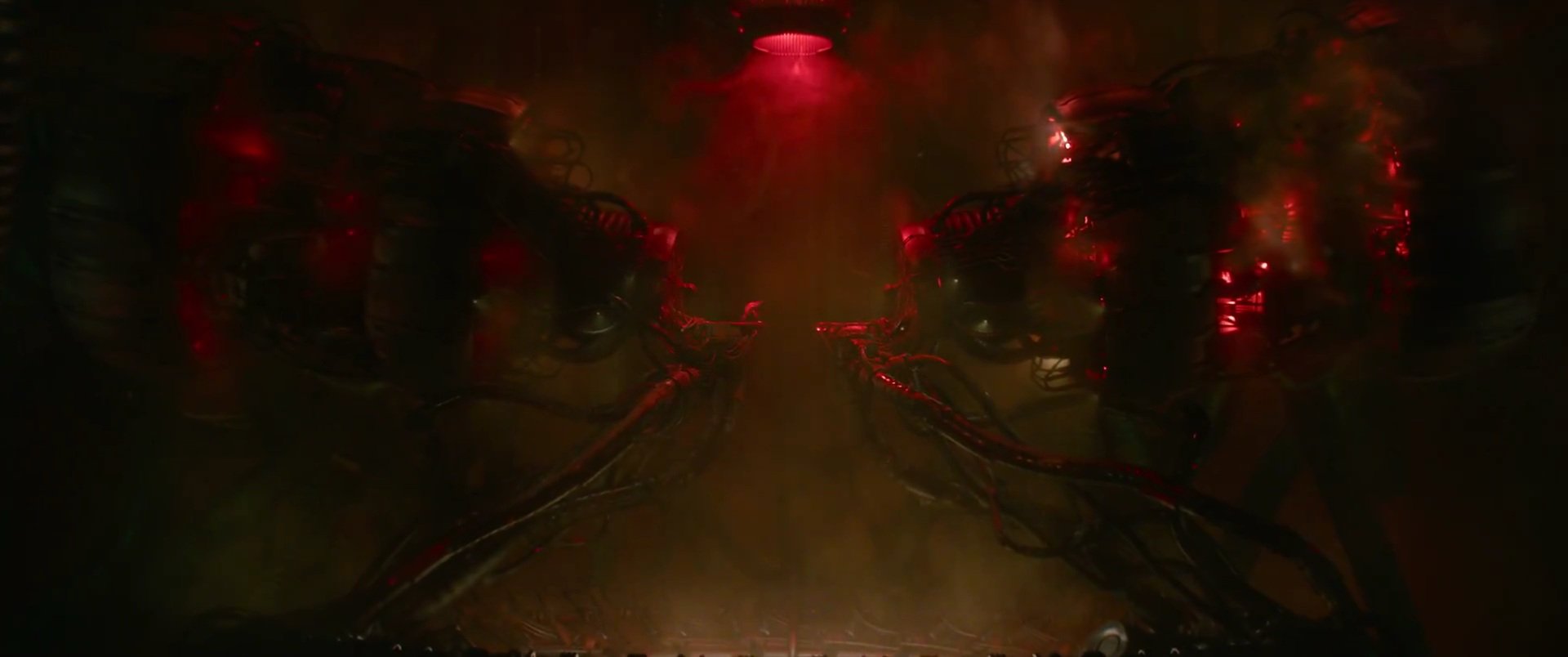Spoilers/prerequisites: All of The Matrix Resurrections.
Previously:
 Up front, I really liked The Matrix Resurrections and I think you should watch it, but whether the movie was good or bad isn’t my focus here. Even if you don’t enjoy it, I still consider it to be a significant work and worthwhile to study and discuss as a text. These are notes and observations on my experiences as a trans woman watching the first new Matrix sequel by an out trans woman, and what I saw as possible meanings and interpretations of it.
Up front, I really liked The Matrix Resurrections and I think you should watch it, but whether the movie was good or bad isn’t my focus here. Even if you don’t enjoy it, I still consider it to be a significant work and worthwhile to study and discuss as a text. These are notes and observations on my experiences as a trans woman watching the first new Matrix sequel by an out trans woman, and what I saw as possible meanings and interpretations of it.
This movie made me uncomfortable, and it succeeded in expressing something meaningful through that discomfort. Shortly before the release of Resurrections, I went over several points of comparison between the events and style of the original trilogy and the dissociative experience of depersonalization-derealization disorder. This disconcerting sense that the world or oneself feels essentially “unreal” often begins in early childhood or at puberty, is unusually common among trans people, and often goes away after transitioning. Neo’s experience in The Matrix has long been understood as a metaphor for transness. Part of that transness could be the all-encompassing faded green of a false-seeming reality with no depth, the flat backdrop to your meaningless and empty self simply going through the motions of life, constantly tormented by the inescapable and unbearable “splinter in your mind” feeling of “something wrong with the world”.
Resurrections does not seem to be primarily about feeling one’s way through an uncomfortable sense of unreality. If the trilogy was about having gender dysphoria and depersonalization-derealization, Resurrections is about even more severe expressions of dissociation such as extreme absorption and amnesia, including apparent episodes of actual loss of contact with reality, hallucinatory flashbacks, and having no memory of periods of time. Whereas depersonalization disorder is notably associated with experiencing emotional neglect from one’s parents or family, this extreme dissociation is the result of the prolonged severe trauma of physical, emotional, or sexual violence and abuse, typically during childhood.
As trans writer Emily VanDerWerff notes at Vox, this is a film about trauma. Neo has frequent and intrusive memories of his life with Trinity and her violent death, and is not even given the validation of knowing that these memories are real. Instead, his Analyst insists that he use grounding exercises to convince himself that his real experiences, in which he is slowly becoming aware of his true self and seeing the nature of the matrix, are in fact hallucinations or psychosis – those episodes of dislocation and missing time, it turns out, are being directly manipulated by the Analyst. That same Analyst, successor to the Architect as the ruler of the matrix after a war between machine factions over dwindling human energy, is responsible for Neo and Trinity’s physical rebuild and resurrection after their deaths in Revolutions.
This sequel feels different.
This movie was a reminder that the Wachowskis really can depict body horror quite effectively, whether it’s your mouth disappearing from your face, your navel becoming an unexpected orifice for use by mechanical insects, or being covered in metal ports so a large communications spike can be inserted through the center of your brain. Resurrections is perhaps more graphically violent and disturbing than the trilogy. The One’s role of returning his program to the source, as explained in vague terms by the Architect in Reloaded, is depicted here in all its awful details: awake and in excruciating pain, Neo’s chest cavity is held wide open as insectoid machines scurry in and out to inspect its contents, and tiny bugs creep along the surface of his fully exposed brain. Next to him, Trinity screams as a massive glowing beetle crawls out of her throat. They are tortured at length as subjects of indefinite human experimentation.
Within the latest matrix, the system’s swarm mode can commandeer all bodies in an area to attack using whatever weapons are at hand, and instead of taking the form of Agents that can cleanly phase around bullets, these unfortunate bluepill bystanders can’t and don’t even try. As a result, it often becomes necessary for our characters to commit what looks like a full-auto mass shooting of everyone in the vicinity, and this movie doesn’t shy away from showing the expected mess. Resistance fighters being brutalized in the matrix also have more blood pour from their actual nose and mouth than previously seen, while inside the matrix a program’s jaw is fully wrenched off, and their exquisite decapitation makes it clear that they’re also made of meat.
There are numerous depictions of suicide, forced suicide and attempted suicide, including innumerable swarms of bots hurling themselves out of buildings with their bodies visibly exploding in blood all along the streets, and how you feel about that may depend on whether you’re old enough to remember 9/11. Suicide attempts are discussed repeatedly as a potentially life-changing catalyst of personal development. Our heroes’ infiltration to rescue Trinity’s body and mind from the new matrix requires shutting down a human shredder. A repellent misogynist (and gushing Matrix fan) shamelessly objectifies Trinity to Neo’s face; one of her children makes a jarringly sexual comment about her and Neo. The plot may even appear to be superficially anti-family on first read. Make no mistake, this is a fucked up movie that knows it. Though Lana Wachowski clearly expresses the futility of trying to duplicate the singular moment of the first Matrix and once again pull off something just as visually revolutionary and culturally influential, something about this movie still feels much like the dank, visceral and grimy virtual-reality sci-fi and horror films that we might have passed around as kids in the ‘90s.
As dangerous and violent as this new matrix is, it’s just as emotionally gutting and continuously traumatic to Neo and Trinity. Rather than the system using individual bodies as fungible units of heat, Resurrections fuses this with the discarded idea from the first Matrix of humans serving as a massive parallel processing network for the machines. Here, the Analyst has resurrected Neo and Trinity to use them as a unique source of power. By ensuring they will always remain alienated and can never be together, he draws energy from their misery at their separation and lack of fulfillment. Trapping them in this “I Have No Mouth and I Must Scream” technological hell where death can’t save them and life can’t unite them, the Analyst shuffles, stitches, and overwrites their memories and realities with abandon to cultivate and enhance their pain. Neo eventually finds these disorienting episodes and intrusive memories of his past life so unbearable, he drunkenly steps off the edge of a building, hoping to exit this life one way or another.
The villain is dysphoria.
This distressing gulf, between where one is and where one needs to be, is a representation of gender dysphoria throughout the film, and the evolving relationship between Neo and Trinity is a detailed depiction of this unendurable state. Their second conversation at the café is a beat-for-beat exploration of the kinds of deeply personal conversations that trans and gender-questioning people have always had with one another as a way of comparing notes, feeling out who and what we are and why this question compels our attention. Such a discussion in a Matrix movie is worth examining closely.
Trinity, still under her Analyst-assigned name “Tiffany”, comes to Neo (“Thomas”) having looked into his background and his work extensively, but only slowly and reluctantly opens up about just how extensive her interest is. She openly admits that in her role as a wife and a mother, she is not sure if she is living the life she actually wants or only filling a role because she was told that this was expected of her. She even wishes to pursue therapy further but is kept in a state of constant exhaustion by the needs of her family. She sees something in someone else, the character of Trinity as depicted in Neo’s “video game”, that resonates so strongly for her that she feels it reflects an essential part of who she is: this is what she looks like and what her life must look like. For her, the question of “or do I want to be her?” is answered unambiguously. Trinity identifies with this self-image so intensely that she opens up to her husband about how much she looks like Neo’s character, only to be misunderstood and laughed off by him as if she’s self-evidently ridiculous for believing this.
The score takes an eerie turn; she knows that her role to play in the order of things is to go along and agree and laugh at these feelings as impossible absurdities, and she experiences complicity in this expected self-ridicule as a moral wound and betrayal of herself. This rejection and withdrawal back into the closet upsets her so profoundly that she has an unusually strong urge to hurt her husband. She’s trying to understand why she hates so much the way her husband sees her, and she’s surprisingly comfortable talking about this almost immediately with a new acquaintance – she senses that they have something in common that is very important to their lives, and that her feelings will be shared and understood. Both awkwardly realize that the conversation has taken a deeply personal turn to the kind of thoughts they usually don’t share with anyone else, but they both come away from it changed.
This matrix, we soon find, is also more literally haunted by dysphoria ghosts. For just a moment Neo glimpses her reflection in the tabletop, a pale woman seen through dark glass who is not Trinity at all.
This “Dark Tiffany” (Sarah McTeigue) is actually all that her husband can see when he looks at her, while Neo easily sees that she looks exactly like Trinity. Only later do we find out that this discrepancy is the work of the Semblance system, which has superimposed a false body image that does not show who they are inside; when Neo is shown this outward image, he’s visibly shaken by his appearance as an old and balding man (this reaction to the vision of himself as old and bald holds a familiarity that makes it very obvious this was the work of a trans woman). The next time they meet, Neo immediately addresses her as Trinity.





